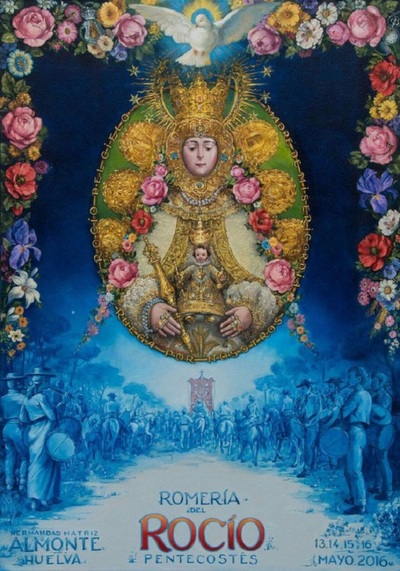The Walk/Pilgrimage to El Rocío
When a Rociero (Devout of Our Lady of Rocío) speaks of the walk, he or she is referring the journey taken with their perspective brotherhood, from their native village or city and ending in the Village of El Rocío at the Sanctuary of Our Lady of Rocío. This walk ends with the presentation of their brotherhood’s Sinpecado (banner) to the image of The Virgin Mary. The Sinpecado is traditionally carried is a specially decorated wagon pulled by oxens and decorated as a mobile sactuary.
The road is a time of reflection, a time to get in touch with the natural area along the route, a time to make new friends, strengthen old one friendships, and most of all to reflect on ones life and our relationship with God. People sing, pray, laugh, dance and cry, and long for the brief presence at the feet of the image of The Mother of God.
The walk is a rustic experience without the amenities of our times filled with the comarodity of brotherhood, purpose, and a time to experience the traditions of the people of Andalusia.
Although there are pilgrimages made by each individual brotherhood throughout the year, the General Walk when all brotherhoods attend always ends on the Sunday of Pentecost, with the procession of Our Lady taking place on Monday of Pentecost.
The newly established European Walk of El Rocío begins in Brussels with stops along many of the important Marian shrines throughout Europe including, Bouraing, Rocamadour, Lourdes, El Pilar, La Almudena, Our Lady of The Kings, Our Lady of La Cabeza, and finally el Rocío. The walk was established with the hopes of uniting all Christians throughout Europe through the devotion of Our Lady of Rocío.
When a Rociero (Devout of Our Lady of Rocío) speaks of the walk, he or she is referring the journey taken with their perspective brotherhood, from their native village or city and ending in the Village of El Rocío at the Sanctuary of Our Lady of Rocío. This walk ends with the presentation of their brotherhood’s Sinpecado (banner) to the image of The Virgin Mary. The Sinpecado is traditionally carried is a specially decorated wagon pulled by oxens and decorated as a mobile sactuary.
The road is a time of reflection, a time to get in touch with the natural area along the route, a time to make new friends, strengthen old one friendships, and most of all to reflect on ones life and our relationship with God. People sing, pray, laugh, dance and cry, and long for the brief presence at the feet of the image of The Mother of God.
The walk is a rustic experience without the amenities of our times filled with the comarodity of brotherhood, purpose, and a time to experience the traditions of the people of Andalusia.
Although there are pilgrimages made by each individual brotherhood throughout the year, the General Walk when all brotherhoods attend always ends on the Sunday of Pentecost, with the procession of Our Lady taking place on Monday of Pentecost.
The newly established European Walk of El Rocío begins in Brussels with stops along many of the important Marian shrines throughout Europe including, Bouraing, Rocamadour, Lourdes, El Pilar, La Almudena, Our Lady of The Kings, Our Lady of La Cabeza, and finally el Rocío. The walk was established with the hopes of uniting all Christians throughout Europe through the devotion of Our Lady of Rocío.
Las Hermandades ~ The Brotherhoods
Rocieros por El Mundo
Rocieros en El Mundo - Website
Hermandad de Rocieros de Corazón - Venezuela
The Following list of Brotherhoods is provided courtesy of Rocieros de Corazón and it's president Mr. Eduardo Bonetti
Rocieros en El Mundo - Website
Hermandad de Rocieros de Corazón - Venezuela
The Following list of Brotherhoods is provided courtesy of Rocieros de Corazón and it's president Mr. Eduardo Bonetti
Haciendo click podrá acceder a las páginas de algunas de la Hermandades
|













